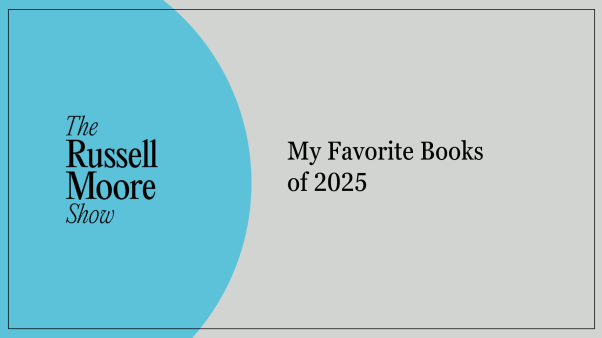A first-of-its-kind study takes an empirical look at the true “value” of faith.
A growing segment of religious nones, with their less-than-flattering views of the role of religious institutions, has led Georgetown University’s Brian Grim and Newseum Institute’s Melissa Grim to calculate three estimates of religion’s socio-economic value to the United States.
“Given the division of opinion on religion’s contribution to American society, this present study seeks to shed light on the topic by making an estimate of religion’s socio-economic value to society,” wrote the father-and-daughter team. “Indeed, we should know if the decline in religion is likely to have negative economic consequences.”
Most religiously unaffiliated Americans think churches and other religious institutions are too concerned with money and power (70%) and too involved with politics (67%), according to the Pew Research Center. And fewer unaffiliated Americans than religious Americans believe that churches strengthen community bonds (78% vs. 90%), help the poor and needy (77% vs. 90%), or do anything to help solve social problems (45% vs. 70%).
But religion, it turns out, is good for the economy.
Specifically, religion is a $378 billion to $4.8 trillion boost to the US economy, the Grims found. Even at the lowest estimate, religious organizations make more than the global revenue of Apple and Microsoft combined; at the high end, religion makes the roughly the same amount as a third of the United States GDP.
A recent journal article explained how the Grims arrived at the three estimates in their study, sponsored by Faith Counts.
“The most conservative estimate takes into account only the revenues of faith-based organizations falling into several sectors: education, healthcare, local congregational activities, charities, media, and food,” they wrote.
The biggest chunk of that comes from health care networks, such as Adventist Health System in Florida, the Baptist Medical Center in San Antonio, Texas, or Riverside Methodist Hospital in Columbus, Ohio. Health care systems like these raise about $161 billion a year.
Congregations raise revenues of $84 billion a year, with $74.5 billion of it coming from individual donations. Religious elementary schools, high schools, and colleges pull in $74 billion, while charities like World Vision, Compassion International, and Samaritan’s Purse bring in more than $45 billion.
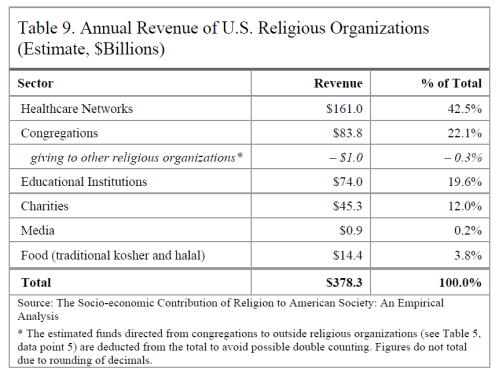
Collected by churches, charities, and religious institutions, the money provides salaries for religious teachers, doctors, and pastors.
And increasingly, it’s spent on social services. The funds pay for food assistance programs, parenting classes, and alcohol and drug abuse recovery programs. They’re spent on youth camps, assistance for the unemployed, and classes on finance management. The amount churches spend on social services was more than $9 billion in 2012, up from about $3 billion in 2006 and $2 billion in 1998.

This first estimate, though, is “an undervaluation because it focuses on revenues rather than on the value of the goods and services provided by religious organizations,” the Grims wrote.
Their second estimate—that religion has an economic value of $1.2 trillion—adds in the price of social services provided by congregations. Churches sponsor more than 1.6 million social services programs in America each year, and provide 7.6 million volunteers. More than 9 in 10 congregations actively recruit volunteers for outside projects (93%), half allow their building to be used for non-congregational purposes (50%), and close to half have groups that think about how to meet community needs (48%).
The Grims also added in the halo effect a community receives from the benefits of having a church nearby: it encourages investment in family and children; stimulates the local economy by buying goods and services; provides a place to host weddings, funerals, or large community events; may run schools or day cares; provides outdoor space for leisure activities; and augments the city’s social services.
The result: $418.9 worth of value.
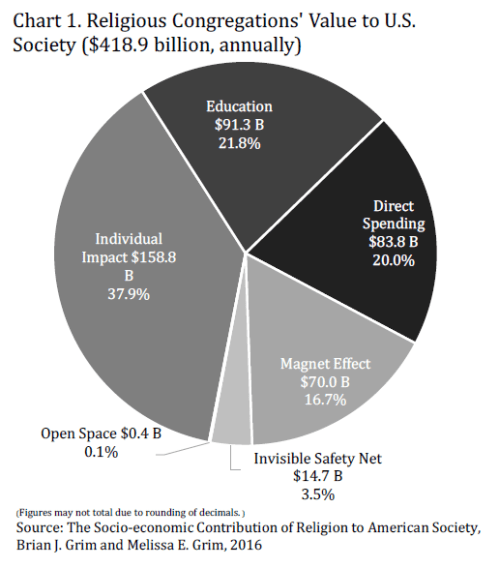
In addition to the expanded value of congregations, the study included religious businesses, taking their cue from the US Supreme Court’s decision that Hobby Lobby can be religiously exempt. That leads to the recognition that some businesses have religious roots, they wrote. Some of the ties are more obvious than others: Chick-fil-A isn’t open on Sunday; Tyson Foods provides 120 office chaplains; Walmart carries Christian books.
Businesses with overt religious ties pull in $422 billion each year, though more than half of that ($279 billion) is Walmart alone.
Here’s the chart again, but with a wider understanding of religious economic impact.
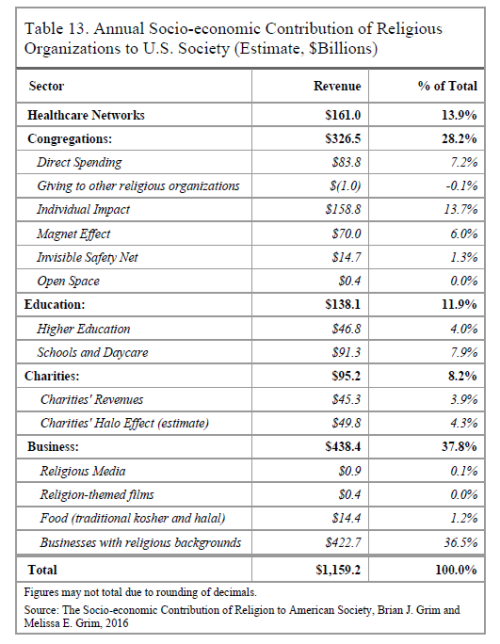
“We believe that our second estimate of $1.2 trillion is a more reasonable estimate because it takes into account both the value of the services provided by religious organizations and the impact religion has on a number of important American businesses,” the Grims wrote.
The third time through, the study calculated just the personal revenues of people of faith. This high-end estimate puts the value of religion in America at $4.8 trillion, the equivalent of a third of America’s gross domestic product.
“The third estimate of this study recognizes that many, if not most, people of faith aim to conduct their affairs (to some extent, however imperfectly) guided by and inspired by their religious ideals,” the study said. “To the extent that religious ethics and ethos pervade how Americans approach work and life, it could be argued that religion’s socio-economic contribution to American society is incalculably large.”
While the third estimate is high, it “takes into account the energetic religious spirit identified by Tocqueville that motivated the public at large toward civic participation and economic vibrancy.”
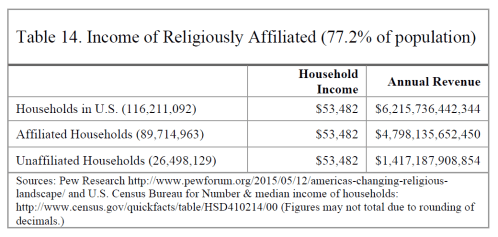
The study wasn’t perfect, the Grims admitted. It didn’t add in any of the financial or physical assets of religious groups, or subtract any negative impacts of religious groups, like fraud or abuse of children by clergy.
And while the halo effect has been studied in some communities, assuming it on the national level may not be a perfect extrapolation.
Still, they wrote, “the data are clear.”
“Religion is a highly significant sector of the American economy,” the study said. “Religion provides purpose-driven institutional and economic contributions to health, education, social cohesion, social services, media, food and business itself. Perhaps most significantly, religion helps set Americans free to do good by harnessing the power of millions of volunteers from nearly 345,000 diverse congregations present in every corner of the country’s urban and rural landscape.”
CT previously examined what a congregation is worth, and interviewed the University of Pennsylvania’s Ram Cnaan on how to tally compassion.










